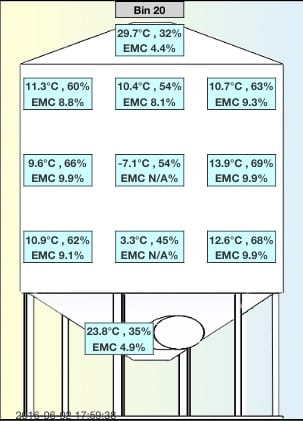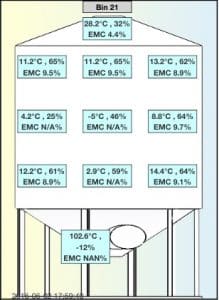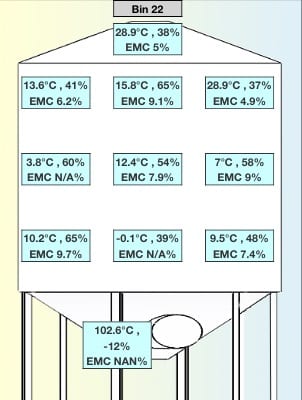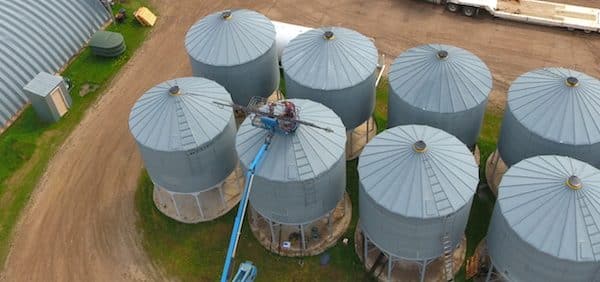By Joy Agnew, lead investigator
The Canola Council of Canada, in collaboration with the Saskatchewan Ministry of Agriculture, PAMI and the provincial Canola grower commissions, is gathering more information to help define best management practices for summer storage of canola. Click here for live updates of in-bin conditions.
2014 results
In 2014, PAMI and the CCC initiated a project to determine how different management strategies affected the potential for spoilage in canola stored over the summer months. Three bins of canola were monitored from June to August. One bin was turned at the beginning of the trial, one bin was aerated to even out the temperature profile, and one bin was left alone. Based on the temperature and relative humidity readings logged over the summer, the bin that was left alone had the most stable conditions throughout the summer. Although there was no apparent spoilage in any of the bins, there were some unstable conditions in the turned and aerated bins. However, the canola was very dry (6.5%) so there was little moisture in the grain to migrate and cause issues. Therefore, PAMI recommended repeating the trial with canola that had a higher starting moisture content. Also, it would be beneficial to collect data from a wider variety of bin sizes to allow more general conclusions to be drawn.
2016 – Higher moisture, bigger bins
In June, 2016, PAMI began collecting data from three bins of canola with an average moisture content of 9%. The same probes used in the 2014 trial were installed in three bins at a farm near Annaheim, Saskatchewan on June 2. Each probe has approximately 5” of flighting at the bottom to assist with the installation as the 1.25” diameter piping results in high resistance at the deeper locations. Based on the 2014 installation some new techniques were devised to install the probes including a taller Genie lift and a drill connected to a reduction drive to “turn” the probes into the canola.
Three bins of canola will be monitored, each with a different management practice. One bin (Bin 20) will be left untouched, another (Bin 21) will be aerated and the last (Bin 22) will be turned. All bins are Westeel-Rosco 4,500 bushel bins on hoppers with 19 ft diameters.
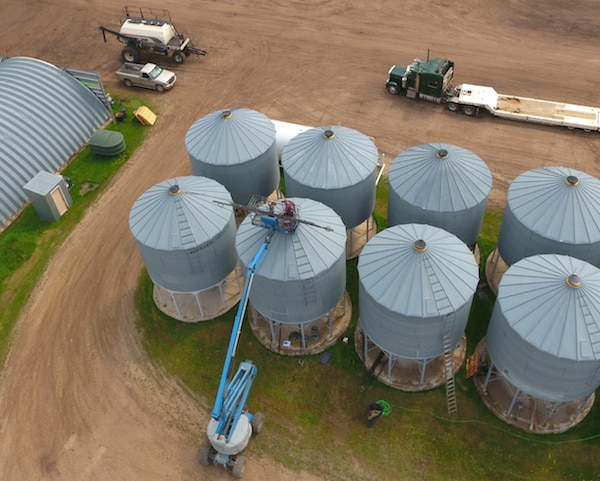
The initial readings (see images at the bottom of this blog) show that the temperature in the core of the bin (sensor 5) was coldest at -6°C. Sensor 8 (on the right side middle of the bin) was highest at 13°C. The insulating properties of canola are amazing!
During the “turning” of Bin 22, the temperature of the canola coming out of the bin was -3.8°C. This is not as cold as the 2014 project, which was close to -25°C. But it did show how the center core of the bin was still frozen. Approximately 400 bushels of canola was removed and replaced at the top of the bin. Enough grain was removed to cause the top layer of grain “fall” into the center. When the canola was loaded back into the bin it had already equalized to around 14°C.
See the live feed
The live feed display allows anyone to monitor the temperature and RH trends in each of the bins. Clicking on any of the boxes provides a display of the 24 hour temperature and RH trend.
Each box shows the real-time temperature (°C), relative humidity (%) and the equilibrium moisture content (EMC). The measured temperature and relative humidity were used to estimate the Equilibrium Moisture Content (EMC) of the air for canola using the Modified Henderson Equation (based on the ASABE Standard). The EMC of the air is NOT necessarily equal to the actual grain moisture content. The EMC of the air represents the moisture content that the grain would eventually reach if the air conditions (temperature and RH) remained constant for a certain period of time. The EMC equation is not valid for cooler temperature (less than 5°C). Therefore, if the in-grain temperature is below 5°C, the EMC readout is N/A.
The readings for each sensor are shown below, all taken at 5:59pm on June 2, 2016. You will notice that Bin 20 and 21 read very similar values, which is what we would expect. Whereas Bin 22 shows obvious signs of being turned with the coldest temperature at the bottom of the bin. The Bin 22 Sensor 7 (top right) seems to be reading the same as the headspace sensor and will be closely monitored to see if it just needs to stabilize or if there is an issue in the grain.
Bin 21 will be aerated at a later date when the ambient temperature is cooler. All of the bins will be monitored regularly via the online display. If any hot spots become apparent, the probes will be immediately removed so the grain can be cared for properly. PAMI will also be intermittently monitoring the conditions in a wide variety of bins sizes and types starting in mid-June. Stay tuned for more updates!
